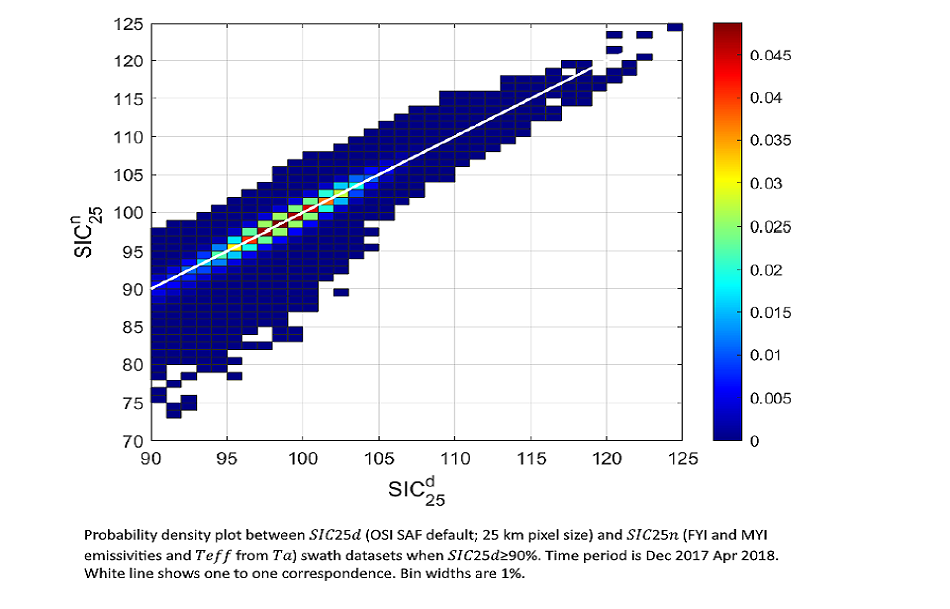05/07/2021
Reduction of regional uncertainty in radiometer sea ice concentration data
-
In the context of the OSI SAF Visiting Scientist Program, Marko Mäkynen from the Finnish Meteorological Institute worked on the reduction of sea-ice concentration noise using brightness temperature correction. This work took place from November 2019 to May 2020 and was supervised by Rasmus Tonboe from DMI.
Objectives and framework of the study
The OSI SAF SIC products, .e.g. OSI 450 (Global Sea Ice Concentration Climate Data Record v2) (Lavergne et al., 2019b) and OSI-408 (AMSR 2 Sea Ice Concentration Maps on 10 km Polar Stereographic Grid) (Tian et al., 2015), have SIC noise, SIC under and over estimations, over high SIC areas, like multiyear ice (MYI) in the north of the Greenland (Kern et al., 2019). These are currently reduced in the OSI-450 product with an empirical 'curved' 100% ice line in the SIC algorithm (not applied in the OSI-408 product). This statistical correction is correcting the hemispherical SIC bias but it does not reduce the near 100% SIC noise, i.e. the spread around the ice line. Therefore, to reduce the noise at near 100% SIC we are looking for a correction based on physical relationships between sea ice properties and measured brightness temperatures (TB), enhanced atmospheric correction of TB data, or enhanced derivation of the 100% ice line that would work on local to regional scale. The ‘curved’ ice line and the physical corrections are not excluding one another, and can be applied together reducing both bias and local noise. The physical corrections could even help in “straightening” the ice line and reducing regional bias. The SIC noise could also come partly from fixed sea ice emissivities used in the TB atmospheric correction (Andersen et al., 2006; Lavergne et al., 2019b), and simple estimation of sea ice effective temperature (Teff) (no ice type dependence) based on the air temperature (Ta). In an ideal case the SIC noise is reduced to the noise level of a radiometer sensor.
Report conclusions
First, we investigate possible improvements to the SIC retrieval by using dynamic sea ice emissivities () and , and their winter season reference values in the atmospheric correction. is estimated either with (a) frequency and ice type dependent (FYI and MYI) vs. relationships by Mathew et al. (2009), or (b) directly from the radiometer data (no ice type dependence) (Kilic et al., 2019). The estimation by Kilic et al. (2019) uses radiometer V-polarization channels from 6.9 to 36.5 GHz, and results in data at the same spatial resolution as SIC is estimated. This method is valid only for sea ice with 100% SIC, but it is, nevertheless, tested over the Arctic pack ice. The dynamic can be monthly mean FYI and MYI emissivities over the Arctic derived by Mathew et al. (2009), or they can be empirically estimated from the original, uncorrected data together with estimates of . Using the available data true cannot be estimated. Instead, we derive ‘apparent’ from daily collection of samples for FYI and MYI and their statistical analysis. We also develop a method for thin ice detection using radiometer data following previous work (Mäkynen and Similä, 2019) in order to exclude thin ice signatures in determination of daily sea ice tie points in the OSI SAF/CCI SIC algorithms. We also investigate if other three channel combinations of 18 and 36 GHz and sums and differences of can yield better quality (less noise and smaller bias) SIC data, after the same OSI-450 algorithm optimization process. For these studies on the SIC improvements AMSR2 L1R data for one winter season for the Arctic, from Oct 2017 to May 2018, are used. In addition, the ERA-Interim data is used for the atmospheric correction, and a combined MODIS-AMSR2 thin ice dataset by Mäkynen and Similä (2019) for investigating detection and exclusion of thin ice samples in the daily tuning of the SIC algorithm. SICs are calculated with OSI SAF OSI-450 simulators (default and improved) programmed in Matlab. These simulators are somewhat simplified versions of the OSI SAF SIC Level 2 processing chains; e.g. land spill-over correction of data is not conducted.
Main recommendations from this study
- We think it would be worthwhile to test new parametrisations in the TB atmospheric correction within the OSI-450 SIC software by metno.
- Teff estimation from the TB data (Kilic et al., 2019) for the TB atmospheric correction does not to seem to be viable solution as in principle the Teff estimates are valid only for 100% SIC.
- Simple thin ice detection method developed here can be used to exclude thin ice pixels (but not all) from the determination of the 100% ice line.
Report on this study: Sea ice concentration noise reduction using brightness temperature correction

